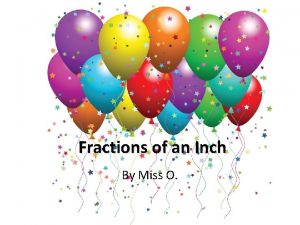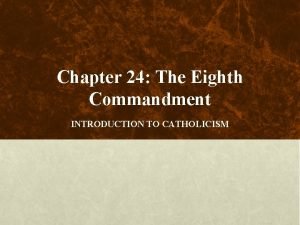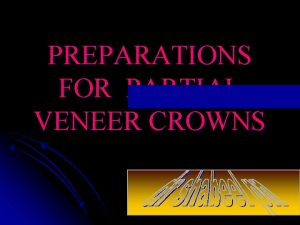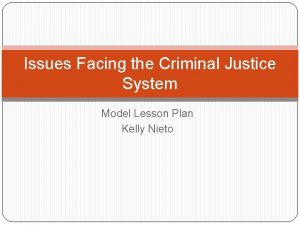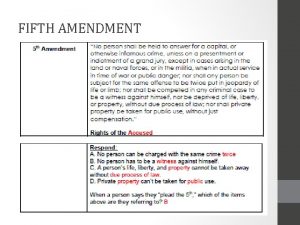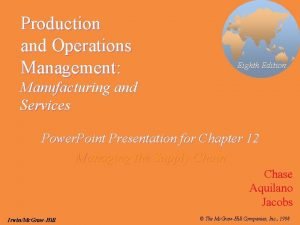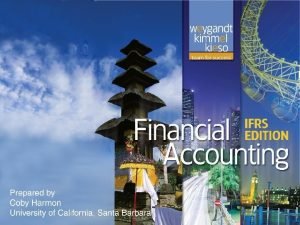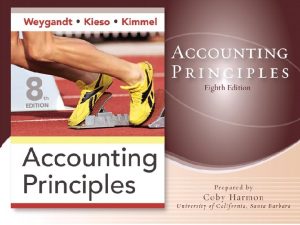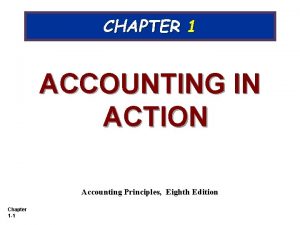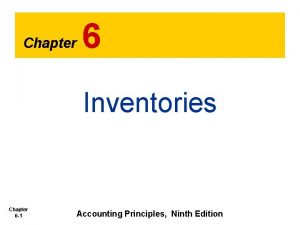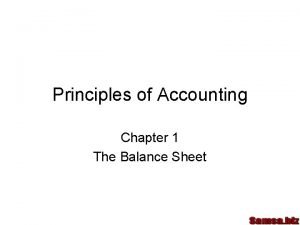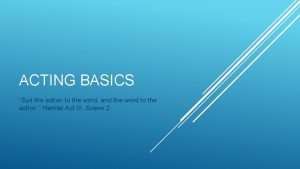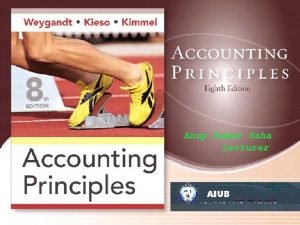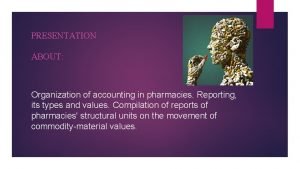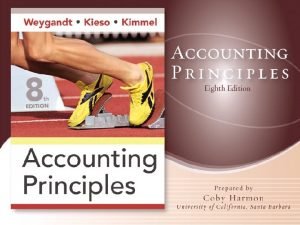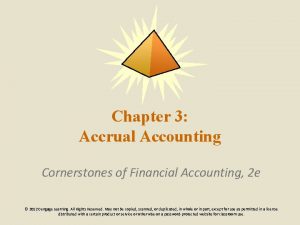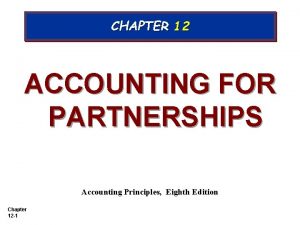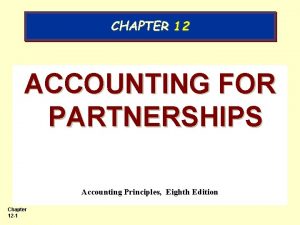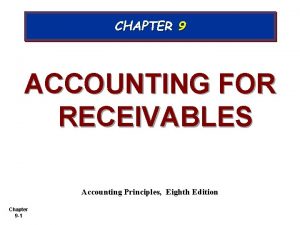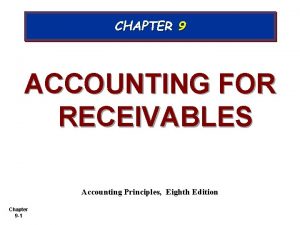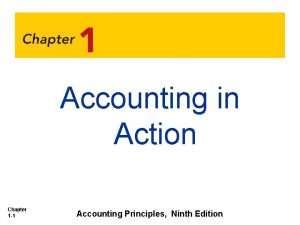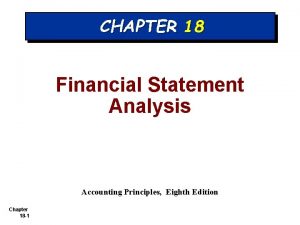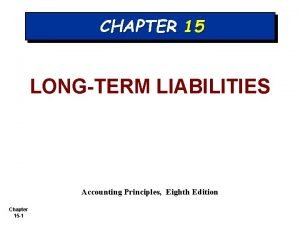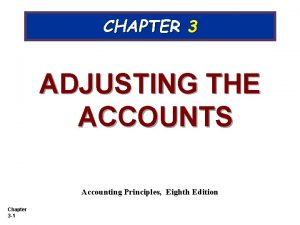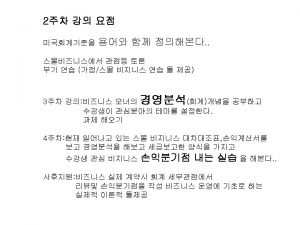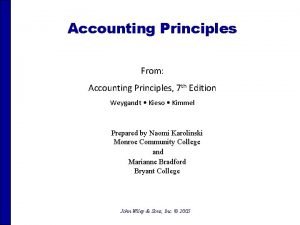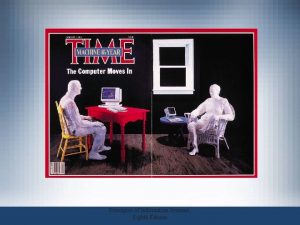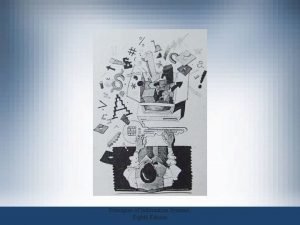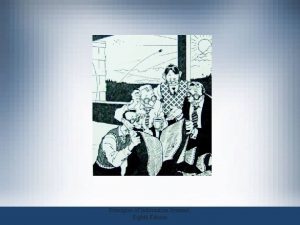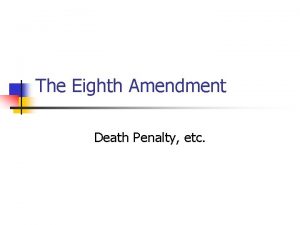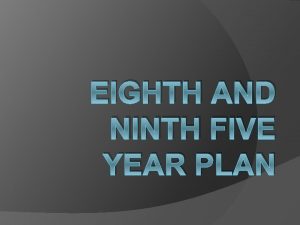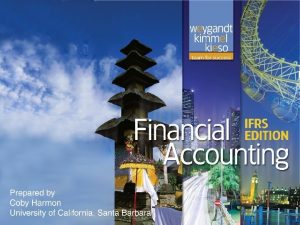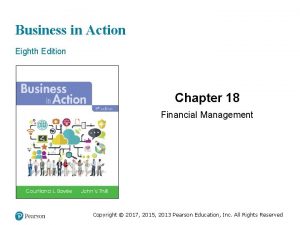CHAPTER 1 ACCOUNTING IN ACTION Accounting Principles Eighth





































- Slides: 37

CHAPTER 1 ACCOUNTING IN ACTION Accounting Principles, Eighth Edition Chapter 1 -1

Study Objectives l Explain what accounting is. l Identify the users and uses of accounting. l Understand why ethics is a fundamental business concept. l l l Chapter 1 -2 Explain generally accepted accounting principles and the cost principle. Explain the monetary unit assumption and the economic entity assumption. State the accounting equation, and define assets, liabilities, and owner’s equity. Analyze the effects of business transactions on the accounting equation. Understand the four financial statements and how they are prepared.

Accounting in Action What is Accounting? Chapter 1 -3 The Building Blocks of Accounting The Basic Accounting Equation Using the Basic Accounting Equation Financial Statements

What is Accounting? The purpose of accounting is to: (1) ? (2) ? (3) ? Chapter 1 -4 LO 1 Explain what accounting is.

What is Accounting? Three Activities Illustration 1 -1 Accounting process The accounting process includes the bookkeeping function. Chapter 1 -5 LO 1 Explain what accounting is.

Who Uses Accounting Data? Internal Users Human Resources Finance Management IRS Investors There are two broad groups of users of financial information: internal users and external users. Marketing Customers Chapter 1 -6 SEC Labor Unions Creditors External Users LO 2 Identify the users and uses of accounting.

Who Uses Accounting Data? Common Questions Asked User 1. Can we afford to give our employees a pay raise? 2. Did the company earn a satisfactory income? 3. Do we need to borrow in the near future? 4. Is cash sufficient to pay dividends to the stockholders? 5. What price for our product will maximize net income? 6. Will the company be able to pay its short-term debts? Chapter 1 -7 LO 2 Identify the users and uses of accounting.

Who Uses Accounting Data? Discussion Question Q 1. “Accounting is ingrained in our society and it is vital to our economic system. ” Do you agree? Explain. See notes page for discussion Chapter 1 -8 LO 3 Understand why ethics is a fundamental business concept.

The Building Blocks of Accounting Ethics In Financial Reporting Standards of conduct by which one’s actions are judged as right or wrong, honest or dishonest, fair or not fair, are Ethics. Recent financial scandals include: Enron, World. Com, Health. South, AIG, and others. Congress passed. Sarbanes-Oxley Act of 2002. Effective financial reporting depends on sound ethical behavior. Chapter 1 -9 LO 3 Understand why ethics is a fundamental business concept.

Ethics Review Question Ethics are the standards of conduct by which one's actions are judged as: • right or wrong. • honest or dishonest. • fair or not fair. • all of these options. Chapter 1 -10 LO 3 Understand why ethics is a fundamental business concept.

Ethics Review Question Ethics are the standards of conduct by which one's actions are judged as: • right or wrong. • honest or dishonest. • fair or not fair. • all of these options. Chapter 1 -11 LO 3 Understand why ethics is a fundamental business concept.

The Building Blocks of Accounting Various users need financial information Financial Statements Balance Sheet Income Statement of Owner’s Equity Statement of Cash Flows Note Disclosure The accounting profession has attempted to develop a set of standards that are generally accepted and universally practiced. Chapter 1 -12 LO 4 Explain generally accepted accounting principles and the cost principle.

The Building Blocks of Accounting Organizations Involved in Standard Setting: Securities and Exchange Commission (SEC) http: //www. sec. gov/ Financial Accounting Standards Board (FASB) http: //www. fasb. org/ International Accounting Standards Board (IASB) http: //www. iasb. org/ Chapter 1 -13 LO 4 Explain generally accepted accounting principles and the cost principle.

The Building Blocks of Accounting Cost Principle – Issues: ? ? ? Chapter 1 -14 LO 4 Explain generally accepted accounting principles and the cost principle.

Assumptions Monetary Unit Assumption – include in the accounting records only transaction data that can be expressed in terms of money. Economic Entity Assumption – requires that activities of the entity be kept separate and distinct from the activities of its owner and all other economic entities. ? ? Forms of Business Ownership ? Chapter 1 -15 LO 5 Explain the monetary unit assumption and the economic entity assumption.

Forms of Business Ownership Proprietorship Chapter 1 -16 Partnership Corporation LO 5 Explain the monetary unit assumption and the economic entity assumption.

Forms of Business Ownership Review Question A business organized as a separate legal entity under state law having ownership divided into shares of stock is a • proprietorship. • partnership. • corporation. • sole proprietorship. Chapter 1 -17 LO 5 Explain the monetary unit assumption and the economic entity assumption.

The Basic Accounting Equation = + Provides the underlying framework for recording and summarizing economic events. Assets are claimed by either creditors or owners. Claims of creditors must be paid before ownership claims. Chapter 1 -18 LO 6 State the accounting equation, and define assets, liabilities, and owner’s equity.

The Basic Accounting Equation Assets = Liabilities + Owner’s Equity Provides the underlying framework for recording and summarizing economic events. Assets ? ? ? Chapter 1 -19 LO 6 State the accounting equation, and define assets, liabilities, and owner’s equity.

The Basic Accounting Equation Assets = Liabilities + Owner’s Equity Provides the underlying framework for recording and summarizing economic events. Liabilities ? ? ? Chapter 1 -20 LO 6 State the accounting equation, and define assets, liabilities, and owner’s equity.

The Basic Accounting Equation Assets = Liabilities + Owner’s Equity Provides the underlying framework for recording and summarizing economic events. Owner’s Equity ? ? ? Chapter 1 -21 LO 6 State the accounting equation, and define assets, liabilities, and owner’s equity.

Owners’ Equity Illustration 1 -6 Revenues: Common sources of revenue are: sales, fees, services, commissions, interest, dividends, royalties, and rent. Chapter 1 -22 LO 6 State the accounting equation, and define assets, liabilities, and owner’s equity.

Owners’ Equity Illustration 1 -6 Expenses: . Common expenses are: salaries expense, rent expense, utilities expense, tax expense, etc. Chapter 1 -23 LO 6 State the accounting equation, and define assets, liabilities, and owner’s equity.

Using The Basic Accounting Equation Transactions are a business’s economic events recorded by accountants. May be external or internal. Not all activities represent transactions. Each transaction has a dual effect on the accounting equation. Chapter 1 -24 LO 7 Analyze the effects of business transactions on the accounting equation.

End Unit 1 Chapter 1 -25

Transactions (Question? ) Q 1 -15: Are the following events recorded in the accounting records? Owner An employee is hired. withdraws cash for personal use. Event Supplies are purchased on account. Criterion Is the financial position (assets, liabilities, or owner’s equity) of the company changed? Record/ Don’t Record Chapter 1 -26 LO 7 Analyze the effects of business transactions on the accounting equation.

Transactions Discussion Question Q 18. In February 2008, Paula King invested an additional $10, 000 in her business, King’s Pharmacy, which is organized as a proprietorship. King’s accountant, Lance Jones, recorded this receipt as an increase in cash and revenues. Is this treatment appropriate? Why or why not? See notes page for discussion Chapter 1 -27 LO 7 Analyze the effects of business transactions on the accounting equation.

Transactions (Problem) P 1 -1 A: Barone’s Repair Shop was started on May 1 by Nancy. Prepare a tabular analysis of the following transactions for the month of May. 1. Invested $10, 000 cash to start the repair shop. Assets Cash Liabilities Equity Accounts Barone, + Receivable + Equipment = Payable + Capital 1. Chapter 1 -28 LO 7 Analyze the effects of business transactions on the accounting equation.

Transactions (Problem) 2. Purchased equipment for $5, 000 cash. Assets Cash 1. +10, 000 Liabilities Equity Accounts Barone, + Receivable + Equipment = Payable + Capital +10, 000 Investment 2. Chapter 1 -29 LO 7 Analyze the effects of business transactions on the accounting equation.

Transactions (Problem) 3. Paid $400 cash for May office rent. Liabilities Assets Cash Accounts Barone, + Receivable + Equipment = Payable + Capital 1. +10, 000 2. -5, 000 Equity +10, 000 Investment +5, 000 3. Chapter 1 -30 LO 7 Analyze the effects of business transactions on the accounting equation.

Transactions (Problem) 4. Received $5, 100 from customers for repair service. Liabilities Assets Cash Accounts Barone, + Receivable + Equipment = Payable + Capital 1. +10, 000 2. -5, 000 3. 4. -400 Chapter 1 -31 Equity +10, 000 Investment +5, 000 -400 Expense LO 7 Analyze the effects of business transactions on the accounting equation.

Transactions (Problem) 5. Withdrew $1, 000 cash for personal use. Liabilities Assets Cash Accounts Barone, + Receivable + Equipment = Payable + Capital 1. +10, 000 2. -5, 000 3. 4. -400 +5, 100 Equity +10, 000 Investment +5, 000 -400 +5, 100 Expense Revenue 5. Chapter 1 -32 LO 7 Analyze the effects of business transactions on the accounting equation.

Transactions (Problem) 6. Paid part-time employee salaries of $2, 000. Liabilities Assets Cash Equity Accounts Barone, + Receivable + Equipment = Payable + Capital 1. +10, 000 Investment 2. -5, 000 3. 4. -400 +5, 100 Expense Revenue 5. 6. -1, 000 Drawings Chapter 1 -33 +5, 000 LO 7 Analyze the effects of business transactions on the accounting equation.

Transactions (Problem) 7. Incurred $250 of advertising costs, on account. Liabilities Assets Cash Equity Accounts Barone, + Receivable + Equipment = Payable + Capital 1. +10, 000 Investment 2. -5, 000 +5, 000 3. 4. -400 +5, 100 Expense Revenue 5. 6. -1, 000 -2, 000 Drawings Expense 7. Chapter 1 -34 LO 7 Analyze the effects of business transactions on the accounting equation.

Transactions (Problem) 8. Provided $750 of repair services on account. Liabilities Assets Cash Equity Accounts Barone, + Receivable + Equipment = Payable + Capital 1. +10, 000 Investment 2. -5, 000 3. 4. -400 +5, 100 Expense Revenue 5. 6. -1, 000 -2, 000 Drawings Expense 7. 8. Chapter 1 -35 +5, 000 +250 -250 Expense LO 7 Analyze the effects of business transactions on the accounting equation.

Transactions (Problem) 9. Collected $120 cash for services previously billed. Liabilities Assets Equity Accounts Barone, + Receivable + Equipment = Payable + Capital Cash 1. +10, 000 Investment 2. -5, 000 3. 4. -400 +5, 100 Expense Revenue 5. 6. -1, 000 -2, 000 Drawings Expense 7. 8. +5, 000 +250 +750 9. + Chapter 1 -36 -250 +750 + = Expense Revenue + LO 7 Analyze the effects of business transactions on the accounting equation.

Financial Statements Companies prepare four financial statements from the summarized accounting data: Income Statement Chapter 1 -37 Owner’s Equity Statement Balance Sheet Statement of Cash Flows LO 8 Understand the four financial statements and how they are prepared.
 Anagram of eighth
Anagram of eighth Psychology eighth edition david g myers
Psychology eighth edition david g myers Inner planets matching
Inner planets matching Nearest quarter inch
Nearest quarter inch Reuptake psychology
Reuptake psychology The fifth, sixth, seventh, and eighth amendments protect *
The fifth, sixth, seventh, and eighth amendments protect * What is the eighth commandment catholic
What is the eighth commandment catholic What is the eighth wonder
What is the eighth wonder Wrench like grip in three fourth crown
Wrench like grip in three fourth crown Eighth amendment excessive bail
Eighth amendment excessive bail Eighth letter of the alphabet
Eighth letter of the alphabet Eighth amendment excessive bail
Eighth amendment excessive bail Seventh amendment meaning
Seventh amendment meaning Operations management eighth edition
Operations management eighth edition Accounting in action
Accounting in action Accounting in action chapter 1
Accounting in action chapter 1 Accounting in action
Accounting in action Principles of accounting chapter 6 answers
Principles of accounting chapter 6 answers Principles of accounting chapter 1
Principles of accounting chapter 1 Financial accounting chapter 1
Financial accounting chapter 1 Exposition rising action climax falling action resolution
Exposition rising action climax falling action resolution The lion and the mouse rising action
The lion and the mouse rising action Rising action of a story
Rising action of a story The black cat exposition
The black cat exposition Suit the action to the word the word to the action meaning
Suit the action to the word the word to the action meaning Principle of dramatization
Principle of dramatization Pla tools
Pla tools Key principles of action research
Key principles of action research Pfa action principles
Pfa action principles Chapter 1 accounting
Chapter 1 accounting Net income will result during a time period when
Net income will result during a time period when Assets = liabilities + stockholders' equity
Assets = liabilities + stockholders' equity Pharmacy accounting principles
Pharmacy accounting principles Inventory costing methods
Inventory costing methods Accrual accounting principles
Accrual accounting principles Accounting principles second canadian edition
Accounting principles second canadian edition Accounting principles second canadian edition
Accounting principles second canadian edition Accounting principles second canadian edition
Accounting principles second canadian edition



